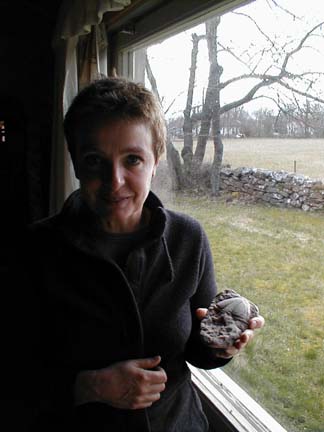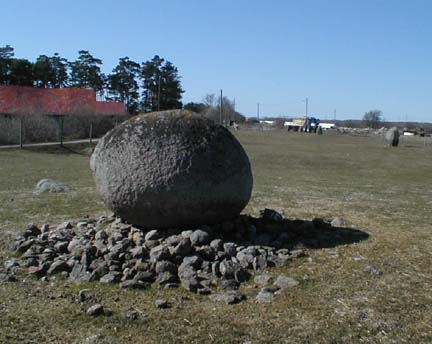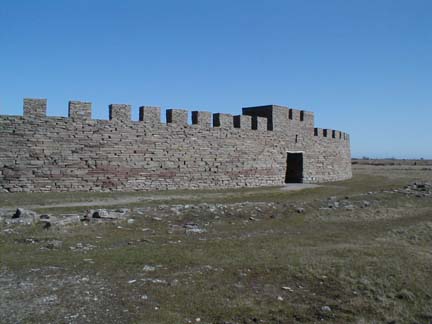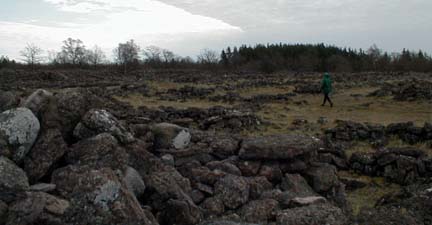
Hans-Goran, aka H-G welcomes us to the summer house at Öland.
Öland is an interesting island off the southern coast of Sweden. (You pronounce the leading vowel by shaping your mouth as if you are going to say O as in yo and then saying A as in hay.) Elsa has a family summer home on the island and invited Ellen and me to join her for a weekend of exploration.

The first day's exploration was astonishing.
We went to Aleklinta beach where a vertical cliff of limestone blocks
loomed over a beach made of rocks. When I hiked onto the rocks I
immediately saw the fossils. The first ones I saw were straight cones
divided into sections like ammonites. Ellen and I danced along the
beach showing each other fossils. We found some nearly a meter
long.


Fossils of orthoceratitens, conical animals from the Cambrian,
they remind me of linear ammonites.
The left image shows two linear fossils and one circular cross
section. Click the left image for an enlargement.
H-G said that Linneas himself had visited this beach and seen the fossils. Ellen and I walked the beach and saw thousands of fossils. But Elsa had the best find of the day, a fossil tail section of a trilobite, perhaps of paradoxides paradoxissimus. Elsa joked that she was the fossil.

H-G showed us birds then set up a spotting scope
to give us a closer view.
Elsa picked up a swan wing and gave it to Ellen.
H-G carried it to the top of the cliff for her.
He paused at the top, turned around, spotting scope over one
shoulder, swan wing in the other hand, silhouetted against the sunset
sky. It looked like a scene from a Felini movie.
At a dinner of quiche made by H-G and Ellen, H-G said that he had hiked the beach a dozen times and never seen the fossils in the rocks.
Friday evening Elsa's brother Peter, a fifth grade teacher with the vast knowledge of everything which is exactly what you need to be a fifth grade teacher, and his energetic wife Anja joined us.
On Saturday we headed down the island to its southernmost point, södre udden, to the bird refuge. Birds stop here after crossing the Baltic on their way from Europe to Sweden and the arctic.
On the way I saw more geology, the glaciers had been to Öland, spherical granite boulders covered the flat limestone of the island. There was no doubt that these were glacial erratics, there is no granite anywhere on the island. The iron age peoples had used many of them to mark graves.

On the trip down the eastern edge of the island we stopped to see an iron age fort which had been reconstructed on the original foundation, Eketorp.

The next day, we visited an iron age ruin in the center of Öland named Ismantorp. Even in its collapsed condition it was impressive. a rock wall 150 meters in diameter, 4 meters thick and probably 4 meters high. Someone moved a lot of limestone!

We made it to the end of the island where we watched birds. Thank goodness H-G had a great book which translated Swedish bird names into English. The south point had a great bird observing shelter that blocked the cold wind.

With the help of my excellent guides, I added a few birds to my life list, a widgeon, a barnacle goose, a robin (European), a snipe (honest), a lappwing, and several more.
H-G was great at identifying birds from their songs.
Thanks to our hosts we had a great weekend in a unique part of Sweden. We saw many sites and, as usual, learned of many more that we have to return to see.